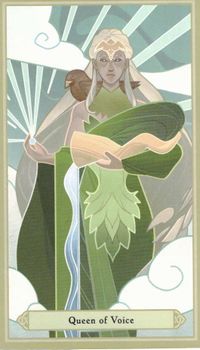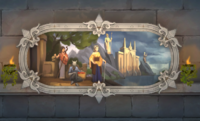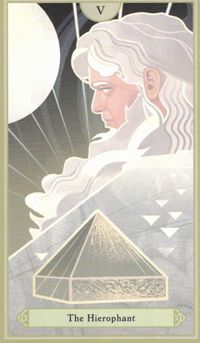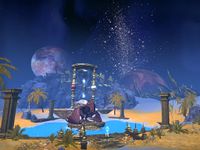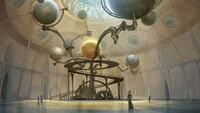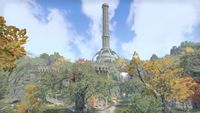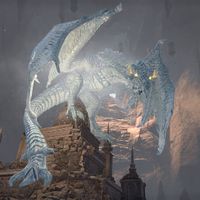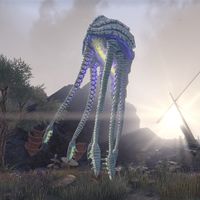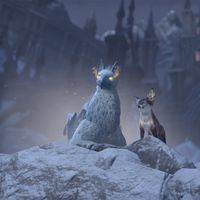Lore:Aedra
The Aedra (also called the Dead Gods or The Mortal Gods or The Outer Gods)[1][2][3] are original beings generally believed to have arisen from the interplay of Anu and Padomay. They are regarded as counterparts and in a manner opposites of the Daedra, though the distinction between the two can be confusing to the layman and the terms Aedra and Daedra, gods and demons, are often used interchangeably. The terms "Aedra" and "Daedra" are not relative, they are exact elvish titles which translate to "ancestors" and "not our ancestors" respectively, representing the mythical genealogy of the elves as they perceive it. The divide between Aedra and Daedra is commonly thought to have originated after their birth, during the creation of the Mundus, where most cultures maintain the Aedric beings played a leading role in the creation of Nirn, causing them to commonly be considered the creators of the mortal world.[4][5][6][7][8] Aedra translated into Aldmeris means "ancestors".[9] The proper singular form is "Aedroth",[UOL 1] but the Aedra are almost never referred to in singular.
In "common parlance" the term "Aedra" is generally reserved for the eight great spirits that followed Lorkhan and created the Mundus. However, according to Vivec, this is folly and a mistake, as some of the creator spirits were not even among the greatest of the Aetherius aligned et'Ada originally, but only gained that standing through making the world, their "creation of the Dawn". Thus the term Aedra is more accurately applicable more broadly and beyond the Eight.[UOL 2]
Contents
Mythology[edit]
The exact nature of the Aedra and of their role in the creation of Nirn and the mortal life that inhabits it are matters shrouded in much ambiguity, different cultures provide different accounts of the circumstances that lead to the creation of the mortal world and of the role the Aedra played in it.
Altmer[edit]
According to the creation myth of the Altmer, "The Heart of the World", creation begins before the start of the Dawn Era and the beginning of time: the primordial force of Anu the Everything, who encompassed and encompasses all things, created Anuiel, the soul of all things, so it could know itself. Anuiel in turn created Sithis for the same purpose, as the sum up of all limitations which it would use to differentiate between it's attributes and ponder itself, and their interrelation created the Aurbis, where the Original Spirits, the Et'Ada, emerged before the creation of the Mundus as "aspects of Aurbis". The Aurbis, at first turbulent and chaotic, was stabilized by the emergence of Auri-El, the soul of Anui-El who spread through existence as the force called time, allowing the Original Spirits to take on names and identities. One of these spirits was more of a limit than a nature, called Lorkhan, he convinced the other spirits to help create a "soul" for Aurbis, a place where even the aspects of aspects might self reflect, but this was a deception. The new world, Nirn, was a place composed of more limitations than not and the spirits that participated in its construction began to die and many vanished completely, prompting the architect, Magnus, to terminate the project and depart. When Magnus departed the Mundus, the et'Ada that took part in its creation broke into groups, most would follow the flight of the God of Magic to become the Magna Ge, but some of those present chose instead to stay in the new world and keep working on it so it wouldn't die, laying, the foundations of both the system and laws of Mundus and the mortal life that would emerge. Of these remaining spirits some would follow the example of Y'ffre, giving themselves to the Mundus fully to stabilize it and form the foundation of its natural law, and would typically be referred to from that point on as "Earthbones" or "Earth Bones". Others would choose not to give themselves fully but to populate Nirn instead, having to "make children just to last", this group of spirits would from that point typically be referred to as the "Ehlnofey".[UOL 3] The offspring of the Ehlnofey would exhibit a gradual change however, each consecutive generation was weaker than the one prior, more removed from their progenitors in stature and might. Through this generational phenomenon of diminishment the offspring of the Ehlnofey would also differentiate, the Ehlnofey would eventually give away and the first Aldmer would arise, while the "weakest souls" that resulted from it would be formed by Lorkhan into armies he named "Men". Altmeri myth holds that Auri-El and Lorkhan and their respective followers would than war with one another, leading to the shattering of Altmora, the "Elder Wood" and one of the first kingdoms established by Auri-El alongside Old Ehlnofey, at Lorkhan's hands, and culminating in the removal of Lorkhan's Heart following his defeat. During this conflict and prior to Lorkhan's defeat, Auri-El begged Anu to take them back but Anu refused as he'd already created something to replace them. The more merciful Anui-El created Auriel's Bow and Auriel's Shield to be used by Auri-El against Lorkhan's hordes. Following the establishment of the Adamantine Tower Convention was held, Lorkhan was judged, the laws and roles of spirits within the Mundus were defined, and the Aedra elected to make their exit from mortal affairs due to the danger their continued presence posed to the mortal world, which was rendered highly unstable, and even the timeless continuity of existence. With the departure of magic in the mythic sense, linear history could finally begin.[5][6][10][11][UOL 4][12]
Aldmeri and Psijic[edit]
According to "The Psijic Compensation", the basics of Aldmeri belief as explained to Uriel V by the Psijic Order: Aurbis existed for time without measure as the Gray Center between the forces of Anu and Padomay. Within this Gray Center emerged the magical beings of mythic Aurbis, bits of the immortal polarity given life. The first of these was Akatosh, whose existence made it easier for other spirits to structure themselves. For a long time these spirits lived, formed, reformed, and procreated. Eventually, with Lorkhan as the instigator of the decision, the spirits told the story of their own deaths. This process has been described in various terms, as a transfiguration into the concrete non-magical substance of the world, as a war in which all were slain with their bodies becoming the substance of the world, or as a romantic marriage and parenthood where the parent spirits naturally had to die to give way to the succeeding mortal races. Mortals were shaped in the image of the spirits, either consciously molded by them, or sprung forth from the matter left behind by the dead spirits. Having died, these spirits became the et'Ada, and separated themselves in nature from the rest of the magical beings of Aurbis from that point on.[5][6] The Psijics believe, therefore, that the Aedra and Daedra are the spirits of "superior men and women whose power and passion granted them great influence in the afterworld", and were themselves bewildered by their own ancestors, going back to the original progenitors, the Acharyai, while alive.[13]
Cyrodiilic[edit]
According to the Cyrodiilic creation myth, "Shezzarr's Song": the world was formed when Shezzarr convinced a number of the gods, the Aedra, of the beauty of the concept of becoming mothers and fathers. The Aedra, determined to proceed regardless of cost, gave birth to the world and the life within it by sacrificing part of themselves, a painful process after which they were no longer strong and young as they'd been since the beginning. Some of the Aedra, the gods of the elves led by Auri-El, came to regret their choice and sought revenge upon Shezzarr and his allies, resolving to teach their children, the elves, to endure the suffering of the new world with dignity. Others, the gods of Men led by Akatosh, were proud, deeming the new world and the life within it glorious despite their sacrifices, and resolving to teach their children to cherish the concepts of beauty and honor and to love one another.[5]
Yokudan[edit]
According to the Yokudan creation myth, "Satakal the Worldskin": all things originated from Satak, the First Serpent on whose scales all worlds to come rested. Compelled by its Hungry Stomach, Akel, Satak started a neverending cycle of devouring itself and shedding its skin to be reborn and begin anew, becoming Satakal. When things from within the devoured worlds realized the truth of the cycle they began to take names and so the first spirits came to be. These spirits sought to escape Satakal's neverending hunger and found a way to slide between its Worldskins by moving at strange angles, this was called the Walkabout and through it was born a sanctuary from the cycle called the Far Shores. One of these spirits, Ruptga, sired many children and was so tall he placed the stars in the sky to help other spirits escape as well. The mortal world was formed when Sep, created by Ruptga out of previous Worldskins to be his helper, convinced some of the other spirits to stop performing the Walkabout, as they could escape the cycle by inhabiting a new world made of balled up Worldskins instead. This, however, was a trick, as having been formed of its skin Sep too carried much of Satakal's hunger, and wished to devour the spirits who followed him. Too far from the Far Shores to jump back to, and too far from the real world of Satakal to survive, the deceived spirits began to die but were survived by the children they'd made.[5]
Khajiit[edit]
According to the Khajiit creation myth: The gods were born as siblings to the three litters of Ahnurr and Fadomai. Spirits commonly considered Aedra were generally born to the first litter, and spirits commonly considered Daedra were generally born to the second. The goddess Nirni was born to the third litter, alongside the moons, Azurah and, eventually, Lorkhaj. Nirni wished to give birth to children, but had no place where she could do so, so she went to Lorkhaj for help. Lorkhaj made a new place but, as his heart was filled with the Great Darkness of Namiira due to the circumstances of his birth within the Great Darkness, he tricked a number of his siblings into entering this place with Nirni, where many of them had to die to make Nirni's path stable. Furious at the betrayal, the surviving siblings tore out the Heart of Lorkhaj.[8][14] Pre-ri'Datta myths also mention that Nirni eventually died when Y'ffer was also corrupted by the Great Darkness and killed her. Y'ffer himself was later slain by Azurah, Khenarthi and Hircine, and his bones were used to construct a cairn for Nirni.[14]
Reachmen[edit]
According to the Reachmen: Nirn was created by Lorkh, who desired to create not a vibrant paradise but a teaching tool a place that taught through suffering. To create this place Lorkh came to Namira, queen of the infinite realm of spirit, who granted him a place in her endless void to make his new world. As part of his covenant with Namira Lorkh had to make a great sacrifice of his own, a sacrifice which is said to be reflected in the creation of the Briarhearts.[15]
Clockwork Apostles[edit]
According to the Clockwork Apostles: Nirn was created by the "et'Ada Gears", aspects of Anu as is everything else, who were tricked by Lorkhan into believing the Great Lie, that they were separate from the all encompassing singularity that is Anu, and took names of their own to reinforce this illusion. In this belief the Daedra and Oblivion are nothing more than illusion themselves, a consequence of the flaws of the creation of the et'Ada' Gears creation, the result of the Void taking root within the cracks caused by said flaws.[16]
Argonian[edit]
According to the transcribed creation myth of the Adzi-Kostleel Argonian tribe, Atak the Great Root and Kota the Serpent fought each other for so long that they eventually forgot their fight and became one, forming the entity Atakota. Atakota severed its roots and shed its skin and said the word "Maybe", giving rise to its Shadow, formed of its hunger and shed skin. Atakota continued to roil in a cycle, devouring itself and shedding its skin to be reborn and begin anew, each scale a world that it devoured. From this process the world and spirits arose, with Atak and Kota not in conflict, things now had time to begin and end, and the Shadow too fell asleep. As Atakota slumbered, the spirits started making new things that shared in their aspect and loved them, and they started growing, until they too were as large as Atakota, and forgot it had come before them and had a sleeping Shadow. Soon the worlds and spirits became too big and there was no more room for new things, in desperation, the spirits fell upon the sleeping Atakota and bit into it to drink its blood. Eventually the peace of Atakota broke, Atak remembered growing and Kota remembered being nothing, and existence fell into chaos again. In that time of chaos some spirits drank deeply of Atakota's blood and sap, and they grew scales and fangs and wings, forgetting why they'd ever made anything other than to eat it. Kota's blood made new oceans and Atak's sap made new stones. Eventually the roots woke the shadow and asked for its help, and its intervention put an end to the chaos that was threatening to consume everything.[7]
Other Beliefs[edit]
Though most creation myths credit the Aedra with contributing to the creation of Mundus in some manner, there are exceptions where the formation of the mortal world is described as the work of other forces.
According to the Anuad: all things began with the brothers Anu and Padomay. Their interplay created Nir, who alongside Anu gave birth to the Twelve Worlds of Creation. Jealous, Padomay attacked, but was cast out of time by Anu. Life emerged on the Twelve Worlds but, eventually, a hateful Padomay returned and shattered the worlds with his blade. After Anu defeated his brother, he attempted to save what he could by combining the shattered fragments of the Twelve Worlds into a new world, Nirn. But after he did so, Padomay rose again and the two brothers finally pulled each other out of time forever. On Nirn life was seeded by the survivors of the Twelve Worlds who'd arrived in the new world alongside fragments of their original worlds, the Ehlnofey and the Hist, and during this time the gods and demons of the world, the Aedra, Daedra and Magna Ge also formed out of Anu and Padomay's spilled blood, as distinct groups from the life of Nirn and from each other from the start.[4]
According to the Bretonic tale "The Light and the Dark": two immortal entities representing Order and Chaos chose Tamriel to be their eternal battleground. This everlasting battle would create energies so powerful it distorted the world and created life, including the "people of et'Ada", who would in turn give rise to the gods, and their "daedric enemies", by believing in their myths for so long and so strongly, it caused the energies unleashed by the conflict of the Light and the Dark to bring them into being. According to the grandfather, all of creation exists to echo the battle between the Light and the Dark.[17]
According to the beliefs of the Mythic Dawn, the mortal world was actually the Oblivion plane of Lorkhan, who was actually a Daedric Prince. Per this belief, the Aedra, the gods mortals generally worship, were actually Lorkhan's betrayers, who stole the realm from its true deity and intentionally split Lorkhan's progeny from their divine sparks, so that they themselves would be viewed as the sole exit from the current world.[18][19]
Characteristics[edit]
—Vivec's musings on divinity[20]
Owing to their alleged participation in the creation of Mundus, the Aedra are generally thought to have somehow separated themselves in nature from other spirits of mythic Aurbis. The exact manner in which this process is described differs by source but, generally, the Aedra are thought to be bound to the Earthbones, the rules they themselves established to govern Mundus, and to represent stasis, where the Daedra represent change. In addition, as beings bound by the contract of creation, the Aedra are thought to have become vulnerable to death and thus to being killed as well, whereas the Daedra, to whom such rules do not apply, can only be banished.[9][5]
Owing to them becoming bound to the laws of mortality, the Aedra are sometimes called the "dead gods" or the "mortal gods", sometimes disparagingly.[1][2] They are generally thought to currently reside in Aetherius.[21] Though some sources present a more negative view of their circumstances, naming Mundus as the Aedra's "cemetery", calling them "spent ghosts", or even alleging them to have died as part of the creation of the world, having "died in pursuit of an impossible goal".[22][23][5] Though the Aedra are thought to have endured a considerable cost as part of the creation of the world, they are also generally thought to be capable of creation, of making new things, whereas the Daedra can only change and mimic what's already there.[9][5][24]
Some sources maintain that, prior to Convention, the Aedra held "every power at every time amendment at every ordering", both the world and it's "architect-gods" were "young" and, as a result, though mighty, they couldn't fully manifest themselves within the world. Thus the limits were imposed at Convention.[UOL 4]
According to Vivec some of the Aedra were not even among the greatest of the Aetherius aligned et'Ada originally, but only became such through making the world, their "creation of the Dawn", suggesting creation might've potentially aided the Aedra in some manner in opposition to the common view.[UOL 2]
The sun is said to represent the connection between Aetherius and the Mundus, and to be the conduit through which the influence of certain Aedra such as Auri-El reaches the mortal world.[25][21]
Legacy[edit]
Though for the most part not directly active within the mortal world in a personal sense, the legacy of the Aedra is still occasionally felt both through the marks of their passing on the mortal world, and through the rare direct interventions of those spirits in mortal affairs.
In addition, a number of events have prompted the seeming direct intervention of Aedric spirits.
The Liminal Barriers separating Mundus from Oblivion are the creation of Akatosh through the Sublime Brazier, a sacred cauldron described as Akatosh's first light, which stretches to the very heart of Nirn. During events such as the Planemeld and the Oblivion Crisis, when the barrier was sundered and the mortal world was threatened, Akatosh's power played a crucial role in ending both Daedric incursions and restoring the boundaries between worlds.[26][27][28][29][30][31]
A number of interventions of lesser scale also occurred during 2E 582. On one occasion Kyne intervened and reverted the transformation of Keeper Ormi into a hagraven, after her son Sahun revealed himself to still be alive and prayed for her.[32] On another, the Bosmer Indaenir was revived by Y'ffre as the new Silvenar, after sacrificing himself to cleanse the Heart of Valenwood.[33] During that same year, Sai Sahan was brought back to life by the alleged intervention of Alkosh in the event that he was sacrificed in Coldharbour, as the deity had foreseen the need of his presence to combat the threat of Kaalgrontiid and Laatvulon due to his ability to see across all the Many Paths of time.[34] At that time, Mara also intervened to enable the departed to return as ghosts to share final moments with their loved ones and guide them beyond the mortal realm. This intervention extended even to situations involving individuals from different races with distinct beliefs about the afterlife. Notably, Mara facilitated the reunion of Nuralanya, a Corelanya Altmer, and an Orc named Gurlak in the afterlife.[35][36]
In 3E 427, a number of alleged avatars of the Divines appeared to the Nerevarine.[37]
In 3E 433, Umaril the Unfeathered returned to Tamriel, seeking revenge on the gods who'd aided in his downfall. The Hero of Kvatch, sought out the Crusader's Relics at the behest of the prophet of Anvil, they were granted audience with Pelinal Whitestrake by the gods, and retrieved the artifacts after passing the trials of each Divine.[38][39] After Umaril was vanquished in the spirit realm through the Blessing Of Talos, the Hero of Kvatch was returned to life by the Divines for their deed.[40]
In 4E 201, Mara would intervene again in a similar manner to reunite the spirits of loved ones, even communicating with a priestess of hers and providing information for this to become possible.[41]Other deities, Arkay and Dibella, also allegedly communicated information to chosen mortals during that time.[42][43]
Other events throughout time have been attributed to intervention by the Aedra.
It is said that, during the First Era, Alkosh manifested at Sunspire to put an end to Pelinal Whitestrake's slaughter that threatened to end the Khajiit. As the legend goes, Alkosh fell from the heavens as a shooting star and shouted Pelinal out of Elsweyr with a roar that split the sky, resulting in a Time Wound at the summit of the mountain, where it has remained since.[44]
The Rite of Akatosh is an endeavor held by Cyrodiilic elders during the Old Life Festival in preparation for the New Life Festival, in which their party goes on a pilgrimage to rid the nearby forests of "Old Life", monsters like Goblins, Ogres, and trolls. The party then challenges the manifested Avatar of Akatosh. By successfully defeating this avatar, the elders hope the God of Time will grant them youth or more time, to be at peace, or that the feat will grant them respect.[45] The phenomenon of Solar eclipses is sometimes thought to represent the loss of the favor of Akatosh, and to be possible to undo with diligent prayer to that deity.[46]
Y'ffre is known to send wisps to herald the storms of Rain's Hand. To see one is to see the promise of new growth, new life, and a new chapter in nature's cycle.[47] As part of a covenant with Tu'whacca, three Ansei warriors bound their souls to their blades to create the Ansei Wards - magical relics that prevented even the most powerful necromancers from raising their dead.[48] Mara is thought to have blessed the village of Garridan Stalrous, which was suffering from a drought, with rainfall, to honor his sacrifice.[49]
Minor Aedric spirits exist, but they are rarely encountered since Magnus withdrew from the world at the moment of creation. This is said to be because interfering with Mundus is generally considered to be off-limits for them since the end of the ages of myth and, as a result, they tend to no longer respond to mortals directly.[50] According to some theories, the Luminaries, immortal beings of pure magic, are thought to be creations of the Aedra sent to guide and protect mortals, and the Aedra's children who potentially herald their return, being to Aetherius what non-greater Daedra are to Oblivion.[51][52]
Realms[edit]
The astral bodies in the sky above Nirn, the moons and dominion planets, are believed to actually be the planes of the gods as well as the gods themselves, as seen from the mortal plane.[UOL 5] They are said to actually be different planes of existence in their own right, infinite in size and mass, with their appearance as spheres being only a visual phenomena caused by mortal mental stress.[UOL 5]
In addition to the planets, a number of other realms have been associated with the Aedra as their domains. Sovngarde was created and is ruled by Shor, and the god Tu'whacca is said to be the caretaker of the Far Shores.[53][54][55][10]
Additional realms of existence have been associated with the Time God.
The Spilled Sand is a strange plane of existence that is associated with Alkosh. It consists of an endless expanse of sand interspersed with an oasis of golden trees, and a colossal slumbering golden dragon with scales of pure gold. The twin moons, Jode and Jone, can be seen in the sky alongside a series of stars. The realm is described as not a place but rather a "story that has and will be told time and time again" and "myth made manifest", it is said to exist at once within and outside the tapestry of time, and beyond even the Sands Behind the Stars.[56][34] When questioned on whether the Spilled Sand is the realm of Alkosh itself, Ja'darri would not outright confirm it, answering instead that Alkosh is both weaver and embodiment of time's tapestry and all always exist within time's realm regardless of where they are.[34] The Mask of Alkosh allows for one to journey to this realm when awoken via the blood of a dragon.[57] Some sources claim that Akatosh, Nirn and Oblivion are one, a fact which can be proven through mathematical equations.[58] The "myriad kingdoms of Akha along the Many Paths", the realities beyond Aurbis are thought to be ruled over and safeguarded by Alkosh, who inherited the crown of Akha.[59][60][61] Some sources state that Akatosh created the Beginning Place, rather than being the first spirit born from it.[62]
Though it is acknowledged as a paradox, it is said the Mundus both encompasses and is encompassed by the innumerable planes of Oblivion.[63]
According to some Daedric accounts, Mundus is defined by a degree of malleability which generally doesn't exist within the realms of Oblivion. Whereas Oblivion realms are fundamentally shaped and curated by the will of their creators, Mundus and it's constituent realms submit simultaneously to the ordered influence of the Aedra's remains and the stubborn caprice of Lorkhan. Thus Mundus is "doughy", things within it can be destroyed, but they never remain gone and instances of them inevitably spring up again.[22] Some sources claim that the reason Nirn is filled with natural caverns is that in primordial times they formed a network that functioned like nodes or capillaries for the divine essence of the Aedra that created it.[64]
The Luminaries, which some sources theorize are children or creations of the Aedra, sent to herald their return and guide mortals,[51][52] have their own realms, such as the Wing of the Indrik, Wing of the Dragon, Wing of the Gryphon, and Wing of the Netch, that they formed at their birth.[65]
Cultural Significance[edit]
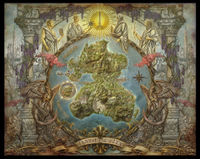
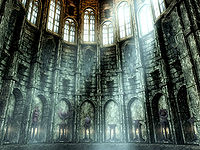
The Aedra generally feature in some manner in the pantheons and religious belief of the races that inhabit Tamriel. As with the various creation myths, the exact perception of each deity in a system of belief varies by culture. Though the Aedra occupy an important role in Tamriel's religious beliefs, they are not the sole objects of worship, and many other saints and holy spirits are known to have their own following.[10]
Owing to the influence of the Empire, eight of the Aedra came to be worshipped as the Eight Divines, namely Akatosh, Arkay, Dibella, Julianos, Kynareth, Mara, Stendarr, and Zenithar. With the addition of Talos, the human god-hero Tiber Septim, they became the Nine Divines. These deities became the central figures of the major religious cult of Cyrodiil and its provinces.[10] According to some Cyrodiilic folktales the Aedra are kind beings that came from an infinite place but intentionally limited themselves and became the world for the sake of mortals. Thus they are everything mortals can see, touch and feel, the world itself. Of the Aedra it is said that Dibella is the most kind.[66]
Of the Aedra, Akatosh and Lorkhan, the Dragon God and the Missing God, are the two who are thought to appear in some capacity and form in all of Tamriel's major religions. The Mother-Goddess Mara is also considered a nearly universal deity in Tamrielic belief, sometimes associated with the female principle of creation, Nir, and with either Akatosh, Lorkhan, or both.[10]
Some of the Aedra feature prominently in a number of Tamrielic religions, though their exact origins, actions, nature, and even names, can differ per belief. These are:
Akatosh is generally thought of as the first god to form at the Beginning Place, though some sources claim he created the Beginning Place rather than being the first spirit born from it instead, he is credited as the origin of time, and it is said that his "perch from eternity allowed the day". The formation of the Dragon God is thought to have made it easier for other forces to crystallize. Akatosh is considered the most active of the Aedra within the lives of mortals, as his presence is felt in the form of time, in each moment that passes. Auri-El, the counterpart of Akatosh within elven belief, is considered the ancestor from whom modern Altmer and Bosmer generally claim direct descent.[10][5][62][63]The laws that govern Nirn and Mundus and the roles of all spirits within them, are believed to have been set in place at and through the Adamantine Tower by its creators. The Tower itself being the seat of Akatosh from where he ruled prior to Convention and the framework set in place itself being described as "the Dragon's timebound tale".[67][UOL 4] This role of the Time God in the order of the world is especially emphasized within Khajiit belief where his counterpart, Alkosh, is said to be at once the weaver of the tapestry of time and the incarnation of the tapestry itself, the threads that comprise it unspooling from the tip of his tail, which would lead to nothing remaining should the thread ever end, as all exists within time's domain.[34] To the Khajiit, Alkosh is responsible for preserving the stability of the world, he is said to maintain the steady movement of the moons, Jode and Jone, it is believed that without him they would freeze in place, allowing terrible things to slip through the Lunar Lattice.[44] It is said that all time flows from Alkosh and that, without him, the world would either sit lifeless or churn like a boiling pot. Because of this, staving off both total chaos and stagnation, his role is considered the most important among all the gods.[68] It is said that Alkosh watches over time's tapestry, whenever a "snag" appears to threaten it, Alkosh realigns the threads with his claws and the aid of the Pride of Alkosh.[69] In Khajiit belief, the Time God's influence is even thought to extend in some manner beyond Aurbis itself, with Akha having created the Many Paths, the realities that exist beyond and surrounding Aurbis, and Alkosh having inherited Akha's crown, role, and myriad kingdoms along the Paths.[59][60][61] Nine Coruscations, a religious text by Ayleid worshippers of Ithelia, describes the Time God's insanity as "all that is and could be", and the layering of linear time upon endless possibility beyond cosmic interplay caused by his afixing of Ada-Mantia. The text also outlines Ithelia's goal of cleaving through that restriction and breaking the shackles of fate, a state known as "Numancia".[70][61]
Lorkhan, is generally thought of as the agent of the communal decision for the creation of Mundus, an act believed to have upset the cosmic balance. Following this act Lorkhan is separated from his divine center, sometimes involuntarily and sometimes willingly. Lorkhan is credited with introducing instability into the cosmos at the Beginning Place, reflecting his Padomaic origins, his actions are central to the Human/Aldmeri schism and have caused him to both be vilified and be viewed sympathetically as the being without whom the mortal world and mortals could not exist, depending on the culture. Because of the controversial nature of his role, the Missing God was given a secondary role in the religious life of Cyrodiil as part of a political compromise.[10][5][71] The cultural counterpart of Lorkhan within the faith of the Khajiit, is described as having a second dark heart, representing his link to the Void, and through it being indirectly responsible for the birth of Noctra.[72][73]
Magnus, believed by some sources to be the architect of Mundus. Following creation, he is thought to have abandoned the project and returned to Aetherius. In doing so, he tore a hole to Oblivion, which became the sun and allowed magic to come to Mundus. Most of the other et'Ada who'd initially participated in the project followed him forming the stars and becoming known as the Magna Ge. For this Magnus is referred as the God of Magic, and is considered one of the Aedra. Despite this, within the Empire, his veneration is sometimes not as pronounced as that of the Divines, as his early departure is viewed in a negative manner, as him refusing to give for the world as much as the other spirits did, and his introduction of magicka is viewed as a dubious contribution that does as much ill as good.[10][5][63] According to some sources Magnus foresaw that the mortal realm would turn out flawed and it was these flaws that made him turn away, he warned the other gods that their current course should be stopped but they chose to proceed anyway, creating the world's suffering. Since than, Magnus watches from the sun, waiting to return when the time is right and the current flawed world is unmade, to make a new world without the flaws of the first in its place. In this capacity, Magnus is thought of by these sources as the indirect origin of the goals of Mehrunes Dagon, who is believed to have been created by the Magna Ge as a weapon to unmake the current world so Magnus can return to reforge it.[74][75][18][19] In some beliefs the relationship of Magnus and the Magna Ge to the sun and stars is changed, with the sun instead being described as one of the eyes of Magnus and the stars being described as fragments of his.[76][77]
Y'ffre is a central deity of the Bosmer. After Magnus and the Magna Ge abandoned Mundus and departed, the spirits who then remained to keep working on Mundus so it'd survive, are said to have either followed Y'ffre's example and given themselves fully to become the stabilizing elements of the new world, its framework of natural laws, becoming known as the "Earthbones". Or "made children", becoming the progenitors of life. These progenitor spirits would come to be known as "Ehlnofey" providing the basis for the meaning of the term "Aedra" or "ancestors.[5][6] The greatest among those spirits who gave themselves fully to form the laws of nature is Y'ffre. Altmer and Bosmer myth describes how during the Dawn Era, both all life, and even the land itself, were formless and constantly shifted between shapes, until Y'ffre's Naming gave all things in Nirn an enduring form. This event, the establishment of shape, is considered a core element of the Green Pact. In certain circumstances such as the enactment of a Wild Hunt, which is enacted in accordance with what the Pact allows, creatures can be made to "forget their Y'ffre taught shapes", causing the bonds of the Naming to unravel, and return to this original formless state.[78][79][80][81][10] Within Bosmer belief Y'ffre is believed to have created day, night, and the places between through the manner in which he interpreted the laws of time established by Anui-El and applied them to Nirn, he is also believed to be responsible for the movements of the stars, as to this day the realms they're windows to sway and wink to his song.[82] Dunmer faith also acknowledges Y'ffre in this capacity of being the deity responsible for the movements of the stars.[83][84] Y'ffre and the Earthbones play a central role in the beliefs of both Druids and Wyrd.[85]The Druids commune with the voices of Y'ffre and the Earthbones for guidance and tap into their power through their magic.[86][87] The Wyresses believe that during Y'ffre's Naming, the act which gave all life on Nirn its shape,[88] the deity tasked the Earthbones to choose those who would become the guardians of nature,[89] a task ultimately given to the Wyresses, the Name-Daughters, who are descendants of the Ehlnofey themselves.[84]
Trinimac is the "strong god" of the early Aldmer and a prominent warrior spirit of the early elven tribes, elven myth credits him with fighting and ultimately killing Lorkhan.[10] A number of Tamrielic beliefs maintain that, at some point, Trinimac disappeared from the mythic stage. Though the sources disagree on the exact circumstances of the event. A number of sources hold that the Daedric Prince Boethiah 'ate' Trinimac taking his form, and appearing before Trinimac's followers to discredit the Aedra. What was Trinimac was released and was now the Daedric Prince Malacath, and his most devout followers were transformed with him into orcs.[90] Or that it was Trinimac who tricked Boethiah, willingly entering the Prince's being to steal some of the other deity's power from within.[91][92] Other variations of this story suggest Trinimac's visage was scarred by a curse and he was banished to a realm of ash, where, enraged at how he was tricked, he tore the shame and weakness from his chest and was reborn as Malacath.[93][93] In Khajiit belief the counterpart of Malacath is instead the demon Orkha, who followed Boethra back from her exile to the Many Paths.[94] One Khajiit source inverts the common roles, suggesting Boethra was the real Trinimac from the start and Orkha only attempted to deceive Trinimac's followers that he was their god before the truth was exposed by the real Trinimac, Boethra. Orkha's attempt to kill Boethra by infusing her body in the form of a curse was prevented by Mephala and Azura but some aspect of the Trinimac he pretended to be remained with Orkha when he was extracted, thus changing him to be more like the Trinimac of old and giving rise to their association. [95] Trinimac is also acknowledged in certain Cyrodiilic folktales, where he is described as the "greatest knight of the Ehlnofey, champion of the Dragon of Time".[96] Whatever the case, the worship of Trinimac would often resurface among the Orsimer, with Trinimac adherents viewing Malacath as either a separate being, or even a deceiver who'd imprisoned the real Trinimac and was trying to usurp his faithful.[97][98][99]
Kynareth is commonly believed to be the Goddess of Air greatest of the Sky Spirits, who was first to agree to the plan to create the mortal plane and provided the space in the Void for its creation.[10] The cultural counterpart of Kynareth within Nord belief, Kyne, is considered the chief of their pantheon, who breathed Men into existence on top of the Throat of the World and leads the souls of the dead to Sovngarde.[100][101] This psychopomp role is also present within the beliefs of the Khajiit, where the cultural counterpart of the Sky Goddess, Khenarthi delivers souls to the afterlife.[102][103] In pre-rI'Datta Khajiit belief, Khenarthi also plays an important role in safeguarding the Many Paths. It is said that, while Alkosh ruled over the children of Akha, he was soon overthrown and his body scattered on the West Wind. It was Khenarthi who than flew along the Many Paths and put Alkosh back together, and now they both "safeguard the Many Paths from the wayward children of Akha".[59] Khenarthi, like Alkosh, is believed to be able to see across all the Many Paths, and is described as the spirit that gave the first sounds to the world.[77][34]
The concept of the Aedra as ancestors is central to a number of elven faiths, and provides the basis for the term "Aedra" itself. Altmer view themselves as "true children of the Et'Ada", descendants of the Aldmer and the Ehlnofey that preceded them, of the Aedra, in an "unbroken line" dating back to Nirn's creation. This belief was central to the ancestor worship of the Aldmer that eventually gave way to the Altmeri pantheon when the religion shifted from the worship of one's own ancestors to the worship of the ancestors of one's "betters", the most influential in their society. Most Altmer and Bosmer claim direct descent from Auri-El himself. Altmer also count deities like Trinimac, Syrabane and Phynaster among their ancestors. Due to this perceived origin, the Altmer believe that within each of them is housed the "divine spark" and thus they've an obligation to keep an Oghma, an "everscriven scroll" in which they memorialize the events of their lives in honor of their divine ancestors.[104][10][5][105][106][11][107] The Altmer use the eagle both in association with Auri-El, from whom they claim direct descent, himself[108][109], and as a symbol representing the Aedra, their ancestors, who descended from Aetherius and became trapped in physical form by the creation of Nirn, as a whole.[110] Altmeri prayers reference Auri-El as the Fixed Center of existence who always envelops all people and invoke him to grant his followers stability.[111] Their prayers often emphasize their believed ancestral connection with the Aedra, urging the faithful to give praise to the Divines and thus to their own ancestral lines, and describing the Altmer as always having the gods in their lives. It is said that the body of the divine wills the Altmer into being, and that they are one with the gods, their ancestors, and so should venerate them as one.[112][113]
The Snow Elves venerated the Aedra and their pantheon overlapped significantly with that of the Altmer. They acknowledged Auri-El as the sovereign and revered Trinimac, Syrabane, Jephre, and Phynaster.[114][115] They had temples to all of them, though none were as impressive as their Chantry of Auri-El.[114] Many of the most dedicated Snow Elves once committed themselves to a tireless journey through the massive Chantry of Auri-El, carrying with them the paramount desire to become one with their god, Auri-El. It is said that those who succeeded and received an audience with the Chantry's Arch-Curate, who was said to have the ear of Auri-El himself, ascended, bathed in light with a look of relief and contentment on their face.[114][116][25]
Few blanket statements can be made about Ayleidic religion. They began as splinter groups, and they were never totally united in their beliefs.[117] But while they are most well-known to historians for being "godless" and "Daedra-loving",[118] their society was fundamentally dedicated to the veneration of the Aedra, not the Daedra, until the last millennium of the Merethic Era.[119] Reverence of the Aedra among the Ayleids in Cyrodiil would recede after the Narfinsel Schism, a civil conflict between the conservative Aedra-worshipping Ayleid clans and the Daedra-worshipping Daedraphile clans, that spanned the Late Merethic Era to 1E 198. The conflict was ended in 1E 198, when King Glinferen of Atatar led a combined force of Daedraphile warriors against the traditionalist forces of Wendelbek, driving the Aedra worshippers from the Heartlands of Cyrodiil and into Black Marsh, giving rise to the Barsaebic Ayleid culture.[120]
According to the Order of the Ancestor Moth, mortal souls are the Aedric essence at the core of every mortal's existence. They believe that the souls of the dead exist in a state beyond mortality, the past and present, and the known world, where time is irrelevant. Thus connecting to the Fjyrons, or "will to peace", of those souls allows one to glimpse the threads of the cosmic tapestry and they represent a connection to the Aedra and the "endless Aedric coil of mortal souls" through the experiences of every mortal who has ever lived. The Cult makes use of this connection via the Ancestor Moths which shepherd the Fjyrons in order to read the Elder Scrolls.[121][122][123] Souls have also been described as the piece of every mortal which comes from Aetherius, the realm of pure light and magic, and a "tiny star" which flares into a "sun" when magic is invoked.[124]
The existence and nature of the Aedra has been subject of commentary by some of the Daedra, though even among them various views exist. The Dremora Lyranth described the Mundus as the "cemetery" of the Aedra, claiming that their original hopes for their mortal descendants and their world were ultimately not achieved due to the mortal's foolishness. Nonetheless, though the creators of Mundus are said to have "died in pursuit of an impossible goal", they are praised for their immense conviction and admired for having wrought order out of chaos, a "brutal coercion" which even Daedra must deem impressive. By contrast, Magnus and the Magna-Ge are viewed as cowards, no other spirits being as low, who fled when things turned dire, thus making it impossible to ever know what could've been achieved had they chosen to stay and keep helping to the end.[22] Contrasting Lyranth's view, the Mazken information broker Madam Whim, claimed that no living being existed which could explain the true relationship between the Aedra and the Daedric Princes, and that no information she'd ever come across in her long life indicated the Aedra were anything more than a story mortals told themselves to feel safer in their beds at night.[125]
Mortals who achieve apotheosis have also found membership in Tamrielic pantheons alongside the Aedra, such as Talos, and possibly Arkay whom some myths attribute to have once been mortal. Syrabane is the Warlock's God, and Phynaster is the Wayfarer God, originally thought to be mortals who ascended to godhood within certain Elven Pantheons and beliefs.[126][10]
The Ehlnofey as a Related Concept[edit]
The Ehlnofey (sometimes spelled Elhnofey) of the Dawn Era are generally believed to be a group of Aedric pre-Convention spirits who, along with the Hist, are counted among the original inhabitants of Nirn, and are widely considered to be the progenitors of the mortal races. The word "Ehlnofey" translates to Earthbones (or Earth Bone) in Ehlnofex. The terms "Earthbone" or "Ehlnofey" are used to denote more than one type of mythical entity. The term "Ehlnofey" is typically used to refer to the spirits that became ancestors of the various mortal races, whereas the term "Earthbone" is typically used to refer to those spirits who followed the example of Y'ffre and sacrificed themselves to form the rules of nature. The term "Ehlnofey" is also used to address eventual Earthbones such as Y'ffre during that stage of their existence prior to becoming laws of nature. The nature of the spirits the term pertains to can vary depending on account.
The concept of the Ehlnofey is of paramount importance within the beliefs of the elves, particularly the Altmer and Bosmer, where the term is used to represent their cultural understanding of the Aedra as ancestor spirits. According to elven myth, the Ehlnofey are considered to be the Aedric spirits who stayed in Nirn after Magnus and the Magna Ge departed in order to keep working on the new world so it'd remain viable. Among those spirits, some, typically referred to from that point on as "Earthbones", are thought to have followed the example of Y'ffre, giving themselves to the Mundus fully to stabilize it and form the foundation of its natural law as the "bones of the earth", eternal laws of nature. While others, typically referred to from that point on as "Ehlnofey", are thought to have chosen not to give themselves fully but to populate Nirn instead, thus becoming the progenitors to mortal life, which arose from their lines and took on its current form due to a phenomenon of gradual diminishment, of each consecutive generation becoming weaker and more removed than its progenitors in stature and might. This understanding forms the basis of the originally elvish term "Aedra" or "ancestor", denoting those spirits which they perceive as being part of their mythic genealogy, including figures such as Auri-El, who most modern Altmer and Bosmer claim direct descent from, Trinimac the "greatest knight of the Ehlnofey", Syrabane and Phynaster. Thus elven religious iconography depicts the Ehlnofey as vaguely Elven in shape, but featureless, similar to how they live on in fading memory.
The Aedra or Ehlnofey are thought to have remained within the world until they vanished. They are thought to primarily reside in Aetherius, having been bound to the Earth Bones as the cornerstones of the Mundus. The terms "spokes", "eight components of chaos", "lent bones of the Aedra", "Bones of the Wheel", "et'Ada-gears" and "Eight gift-limbs" have also been used to refer to them in this capacity, after having transformed into the framework of reality. Some sources present a more negative view of the circumstances of these spirits and their residence in Aetherius, naming Mundus as their "cemetery", calling them "spent ghosts", or even alleging them to have died as part of the creation of the world, having "died in pursuit of an impossible goal". Thus the Aedra are sometimes called the "dead gods" or the "mortal gods", sometimes disparagingly, owing to them having become bound to the laws of mortality.
A direct correlation between the concepts of Ehlnofey and Aedra is not universal among sources. In some accounts, the terms "Ehlnofey" and "Earth Bones" are both described as referring exclusively to the early offspring of the Aedra rather than to those spirits themselves, who were told to populate the world and live on through their children, leading to the gradual emergence of the various races of man and mer. In others the Ehlnofey are described instead as a group of beings who predate the Aedra and Daedra as survivors of a prior world, fragment of which Anu used to create Nirn, whereas the Aedra and Daedra are formed of Anu and Padomay's blood after Nirn's formation and the establishment of the Ehlnofey there, with all groups distinct from the start. The concept of descent from the ancestor spirits is generally viewed as "elven conceit" by the religions of Men who, with the exception of the Redguards, view themselves as creations of those spirits rather than their descendants.
Perhaps because of their association with the land itself, "Old Ehlnofey" became another name for Aldmeris, the mystical homeland of the elves. The language or languages of the Ehlnofey became known as Ehlnofex. It has been found that the "Earth Bones", the laws of nature, can be manipulated to some extent.
For more information, see the article on Ehlnofey
Major Members[edit]
- Eight Divines
- Lorkhan - Creator Trickster God, responsible for the idea of Mundus.
- Trinimac - Elven Warrior God and greatest champion of Auri-El, potentially transformed into Malacath by Boethiah.
- Magnus - God of Magic, considered Aedric by the Imperial Cult though not worshipped like the Eight Divines due to his lesser sacrifice, leader of the Magna Ge.
- Y'ffre - God of Song and Forest, widely believed to have become first of the Earthbones.
Gallery[edit]
The Dragon Luminary, potentially a child or creation of the Aedra
The Netch Luminary, potentially a child or creation of the Aedra
The Indrik Luminary, potentially a child or creation of the Aedra
The Gryphon Luminary, potentially a child or creation of the Aedra
References[edit]
- ^ a b Vastarie's dialogue in ESO
- ^ a b The Prophet's dialogue in Oblivion
- ^ N'Gasta's dialogue in Redguard
- ^ a b The Annotated Anuad
- ^ a b c d e f g h i j k l m The Monomyth
- ^ a b c d Before the Ages of Man — Aicantar of Shimerene
- ^ a b Children of the Root — Solis Aduro
- ^ a b Words of Clan Mother Ahnissi — Clan Mother Ahnissi
- ^ a b c Aedra and Daedra
- ^ a b c d e f g h i j k l m Varieties of Faith in the Empire — Brother Mikhael Karkuxor of the Imperial College
- ^ a b The Mystery of Artaeum — Penewen, Advisor to the Court
- ^ Aurbic Enigma 4: The Elden Tree — Beredalmo the Signifier
- ^ The Old Ways — Celarus the Loremaster
- ^ a b Spirits of Amun-dro — Amun-dro, the Silent Priest
- ^ Great Spirits of the Reach — Vashu gra-Morga, Chief Daedrotheologist at the University of Gwylim
- ^ The Truth in Sequence — Deldrise Morvayn, Fourth Tourbillon to the Mainspring Ever-Wound
- ^ the Light and the Dark — Irek Unterge
- ^ a b Mankar Camoran's dialogue in Oblivion
- ^ a b Mythic Dawn Commentaries — Mankar Camoran
- ^ Vivec's dialogue in ESO
- ^ a b Serana's dialogue in Skyrim
- ^ a b c Loremaster's Archive - Mehrunes Dagon & Daedra in the Second Era — Lyranth
- ^ Glorious Upheaval — Thendaramur Death-Blossom
- ^ Inexplicable Patron: Mephala — Divayth Fyr
- ^ a b Vyrthur's dialogue in Skyrim
- ^ Events of Light the Dragonfires in Oblivion
- ^ Dialogue from the Drake of Blades in ESO
- ^ Trials of St. Alessia
- ^ The Sublime Brazier — Augusta Purusius, Associate Historian, Imperial Academy of Records and Histories
- ^ Abnur Tharn's dialogue in ESO
- ^ Martin Septim's dialogue in Oblivion
- ^ Events of For Kyne's Honor in ESO
- ^ Striking at the Heart quest in ESO
- ^ a b c d e Ja'darri's dialogue in ESO: Dragonhold
- ^ Nuralanya's dialogue in ESO
- ^ Events of The Oldest Orc in ESO
- ^ Lalatia Varian's dialogue in Morrowind.
- ^ Pelinal Whitestrake's dialogue in Oblivion: Knights of the Nine
- ^ Events of Oblivion: Knights of the Nine
- ^ Sir Thedret's dialogue in Oblivion
- ^ Dinya Balu's dialogue in Skyrim
- ^ Florentius Baenius' dialogue in Skyrim
- ^ Hamal's dialogue in Skyrim
- ^ a b Moon-Bishop Azin-jo's dialogue in ESO: Elsweyr
- ^ The Rite of Akatosh event and related Rulings in Castles
- ^ Eclipse rulings in Castles
- ^ Galen Wisp collectible description in ESO
- ^ Throne Keeper Farvad's dialogue in ESO
- ^ Knightfall — Jaren Aethelweald, edited by Kirellian Odrenius
- ^ Phrastus of Elinhir Answers Your Questions — Phrastus of Elinhir
- ^ a b Loremaster's Archive - Scribing — Votary Nahila
- ^ a b Ulfsild's Notes: The Origin of Luminaries — Ulfsild
- ^ Tsun's dialogue in Skyrim
- ^ Tu'whacca's Prayer
- ^ Reverence for the Dead — Brother Opilio Congonius
- ^ Nahfahlaar's dialogue in ESO: Dragonhold
- ^ The Dragonguard quest in ESO: Dragonhold
- ^ The Four Suitors of Benitah — Jole Yolivess
- ^ a b c The Wandering Spirits — Amun-dro, the Silent Priest
- ^ a b Leramil's dialogue in ESO
- ^ a b c Ithelia's dialogue in ESO
- ^ a b The Improved Emperor's Guide to Tamriel: Hammerfell — Flaccus Terentius, 2E 581
- ^ a b c Artorius Ponticus Answers Your Questions — Bishop Artorius Ponticus
- ^ Weeping Wind Cave loading screen in ESO
- ^ The Indrik's dialogue in ESO: Gold Road
- ^ pg.237 of Lord of Souls — Greg Keyes
- ^ Aurbic Enigma 4: The Elden Tree — Beredalmo the Signifier
- ^ Natrada's dialogue in ESO: Elsweyr
- ^ The Pride of Alkosh — Clan Mother Hizuni
- ^ The Nine Coruscations — Star-Queen Varalias
- ^ Shezarr and the Divines — Faustillus Junius
- ^ The Dark Spirits — Amun-dro, the Silent Priest
- ^ The Favored Daughter of Fadomai — Amun-dro, the Silent Priest
- ^ Doombringer Celdina's Testament — Doombringer Celdina
- ^ Sister Celdina's dialogue in ESO
- ^ The Infernal City — Greg Keyes
- ^ a b The Sky Spirits — Amun-dro, the Silent Priest
- ^ The Ooze: A Fable
- ^ Brief Letter to an Aldarch in ESO
- ^ Wild Hunt Horse mount description in ESO
- ^ Wild Hunt Crate descriptions in ESO
- ^ Girnalin's dialogue in ESO
- ^ Of Jephre — Anonymous
- ^ a b Witch Cults of Northern High Rock — Wafimeles Masteret (Lorekeeper)
- ^ Wyrd and Druid — Archdruid Barnabe's Discourse with Mainlanders, 2E 553
- ^ Druid Audrine's dialogue in ESO
- ^ Legacy of the Bretons — Stefan Mornard
- ^ Wild Hunt Crown Crate season description in ESO
- ^ Wyresses: The Name-Daughters — Glargargil the Speaking Oak
- ^ The True Nature of Orcs
- ^ Varieties of Faith: The Orcs — Brother Mikhael Karkuxor of the Imperial College
- ^ The Fall of Trinimac — The Faithless One
- ^ a b Mauloch, Orc-Father — Ramurbak gro-Abamath
- ^ The Adversarial Spirits — Amun-dro, the Silent Priest
- ^ The Bladesongs of Boethra — Modun-Ra, the Hidden Voice
- ^ Lord of Souls — Greg Keyes
- ^ High Priestess Solgra's dialogue in ESO
- ^ Pocket Guide to the Empire, 3rd Edition: Orsinium — Imperial Geographical Society, 3E 432
- ^ Villager Dialogue from Blades during The Heretic questline
- ^ Divines and the Nords — High Priest Ingurt
- ^ Goddess of Storm, Mother of Nords
- ^ How We Came to Fly
- ^ Litter-Mates of Darkness — Moon-Bishop Hunal
- ^ The Onus of the Oghma — Phrastus of Elinhir
- ^ Pocket Guide to the Empire, 3rd Edition: The Blessed Isle: Alinor and the Summersets — Imperial Geographical Society, 3E 432
- ^ A Rejection of Open Borders — Kinlady Avinisse of Shimmerene
- ^ Ayrenn: The Unforeseen Queen — Headmaster Tanion of the College of Aldmeri Propriety
- ^ Driftwood Idol contraband in ESO
- ^ Winged Auri-El contraband in ESO
- ^ Elder Scrolls Online - Knowledge Base
- ^ Coils of the Father
- ^ Praise Be
- ^ Mirnor of Auri-El's dialogue in ESO
- ^ a b c Gelebor's dialogue in Skyrim
- ^ Varieties of Faith... — Brother Mikhael Karkuxor of the Imperial College
- ^ Touching the Sky — Parmion Saldor
- ^ Daedra Worship: The Ayleids — Phrastus of Elinhir
- ^ Guide to the Imperial City — Alessia Ottus
- ^ The Whithering of Delodiil — Unknown
- ^ Ayleid Survivals in Valenwood — Cuinur of Cloudrest, 4th Tier Scholar of Tamrielic Minutiae
- ^ The Distributed Soul — Abbot Crassius Viria
- ^ Loremaster's Archive - Elder Scrolls & Moth Priests — Sister Chana Nirine
- ^ Pension of the Ancestor Moth
- ^ pg. 52 Lord of Souls — Greg Keyes
- ^ Loremaster's Archive - Malacath and Maelstrom — Madam Whim
- ^ Ark'ay The God — Mymophonus the Scribe
Note: The following references are considered to be unofficial sources. They are included to round off this article and may not be authoritative or conclusive.
- ^ et'Ada, Eight Aedra, Eat the Dreamer
- ^ a b The Thief Goes to Cyrodiil — Vivec
- ^ Michael Kirkbride's Posts
- ^ a b c Nu-Mantia Intercept — Nu-Hatta, The Imperial Library
- ^ a b Cosmology — The Temple Zero Society
| |||||||||||||||||||||||||||||||||||||||||||
